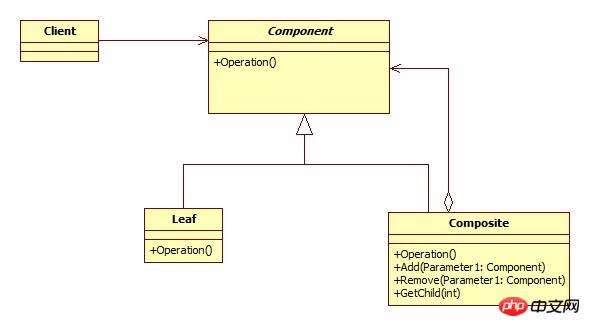Java中組合模型之物件結構模式的實例分析
這篇文章主要介紹了Java 中組合模型之物件結構模式的詳解的相關資料,希望透過本文能幫助到大家理解應用物件結構模型,需要的朋友可以參考下
Java 中組合模型之物件結構模式的詳解
一、意圖
將物件組合成樹狀結構以表示」部分-整體”的層次結構。 Composite使得使用者對單一物件和組合物件的使用具有一致性。
二、適用性
你想表示物件的部分-整體層次結構
你希望使用者忽略組合對象與單一物件的不同,使用者將統一使用組合結構中的所有物件。
三、結構

#四、程式碼
public abstract class Component {
protected String name; //节点名
public Component(String name){
this.name = name;
}
public abstract void doSomething();
}public class Composite extends Component {
/**
* 存储节点的容器
*/
private List<Component> components = new ArrayList<>();
public Composite(String name) {
super(name);
}
@Override
public void doSomething() {
System.out.println(name);
if(null!=components){
for(Component c: components){
c.doSomething();
}
}
}
public void addChild(Component child){
components.add(child);
}
public void removeChild(Component child){
components.remove(child);
}
public Component getChildren(int index){
return components.get(index);
}
}public class Leaf extends Component {
public Leaf(String name) {
super(name);
}
@Override
public void doSomething() {
System.out.println(name);
}
}public class Client {
public static void main(String[] args){
// 构造一个根节点
Composite root = new Composite("Root");
// 构造两个枝干节点
Composite branch1 = new Composite("Branch1");
Composite branch2 = new Composite("Branch2");
// 构造两个叶子节点
Leaf leaf1 = new Leaf("Leaf1");
Leaf leaf2 = new Leaf("Leaf2");
branch1.addChild(leaf1);
branch2.addChild(leaf2);
root.addChild(branch1);
root.addChild(branch2);
root.doSomething();
}
}
输出结果:
Root
Branch1
Leaf1
Branch2
Leaf2以上是Java中組合模型之物件結構模式的實例分析的詳細內容。更多資訊請關注PHP中文網其他相關文章!

熱AI工具

Undresser.AI Undress
人工智慧驅動的應用程序,用於創建逼真的裸體照片

AI Clothes Remover
用於從照片中去除衣服的線上人工智慧工具。

Undress AI Tool
免費脫衣圖片

Clothoff.io
AI脫衣器

Video Face Swap
使用我們完全免費的人工智慧換臉工具,輕鬆在任何影片中換臉!

熱門文章

熱工具

記事本++7.3.1
好用且免費的程式碼編輯器

SublimeText3漢化版
中文版,非常好用

禪工作室 13.0.1
強大的PHP整合開發環境

Dreamweaver CS6
視覺化網頁開發工具

SublimeText3 Mac版
神級程式碼編輯軟體(SublimeText3)
 突破或從Java 8流返回?
Feb 07, 2025 pm 12:09 PM
突破或從Java 8流返回?
Feb 07, 2025 pm 12:09 PM
Java 8引入了Stream API,提供了一種強大且表達力豐富的處理數據集合的方式。然而,使用Stream時,一個常見問題是:如何從forEach操作中中斷或返回? 傳統循環允許提前中斷或返回,但Stream的forEach方法並不直接支持這種方式。本文將解釋原因,並探討在Stream處理系統中實現提前終止的替代方法。 延伸閱讀: Java Stream API改進 理解Stream forEach forEach方法是一個終端操作,它對Stream中的每個元素執行一個操作。它的設計意圖是處
 PHP:網絡開發的關鍵語言
Apr 13, 2025 am 12:08 AM
PHP:網絡開發的關鍵語言
Apr 13, 2025 am 12:08 AM
PHP是一種廣泛應用於服務器端的腳本語言,特別適合web開發。 1.PHP可以嵌入HTML,處理HTTP請求和響應,支持多種數據庫。 2.PHP用於生成動態網頁內容,處理表單數據,訪問數據庫等,具有強大的社區支持和開源資源。 3.PHP是解釋型語言,執行過程包括詞法分析、語法分析、編譯和執行。 4.PHP可以與MySQL結合用於用戶註冊系統等高級應用。 5.調試PHP時,可使用error_reporting()和var_dump()等函數。 6.優化PHP代碼可通過緩存機制、優化數據庫查詢和使用內置函數。 7
 PHP與Python:了解差異
Apr 11, 2025 am 12:15 AM
PHP與Python:了解差異
Apr 11, 2025 am 12:15 AM
PHP和Python各有優勢,選擇應基於項目需求。 1.PHP適合web開發,語法簡單,執行效率高。 2.Python適用於數據科學和機器學習,語法簡潔,庫豐富。
 Java程序查找膠囊的體積
Feb 07, 2025 am 11:37 AM
Java程序查找膠囊的體積
Feb 07, 2025 am 11:37 AM
膠囊是一種三維幾何圖形,由一個圓柱體和兩端各一個半球體組成。膠囊的體積可以通過將圓柱體的體積和兩端半球體的體積相加來計算。本教程將討論如何使用不同的方法在Java中計算給定膠囊的體積。 膠囊體積公式 膠囊體積的公式如下: 膠囊體積 = 圓柱體體積 兩個半球體體積 其中, r: 半球體的半徑。 h: 圓柱體的高度(不包括半球體)。 例子 1 輸入 半徑 = 5 單位 高度 = 10 單位 輸出 體積 = 1570.8 立方單位 解釋 使用公式計算體積: 體積 = π × r2 × h (4
 PHP與其他語言:比較
Apr 13, 2025 am 12:19 AM
PHP與其他語言:比較
Apr 13, 2025 am 12:19 AM
PHP適合web開發,特別是在快速開發和處理動態內容方面表現出色,但不擅長數據科學和企業級應用。與Python相比,PHP在web開發中更具優勢,但在數據科學領域不如Python;與Java相比,PHP在企業級應用中表現較差,但在web開發中更靈活;與JavaScript相比,PHP在後端開發中更簡潔,但在前端開發中不如JavaScript。
 PHP與Python:核心功能
Apr 13, 2025 am 12:16 AM
PHP與Python:核心功能
Apr 13, 2025 am 12:16 AM
PHP和Python各有優勢,適合不同場景。 1.PHP適用於web開發,提供內置web服務器和豐富函數庫。 2.Python適合數據科學和機器學習,語法簡潔且有強大標準庫。選擇時應根據項目需求決定。








